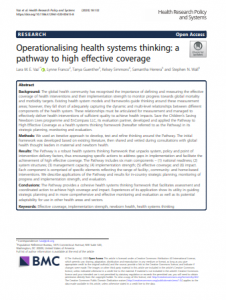
Background
The global health community has recognised the importance of defining and measuring the effective coverage of health interventions and their implementation strength to monitor progress towards global mortality and morbidity targets. Existing health system models and frameworks guide thinking around these measurement areas; however, they fall short of adequately capturing the dynamic and multi-level relationships between different components of the health system. These relationships must be articulated for measurement and managed to effectively deliver health interventions of sufficient quality to achieve health impacts. Save the Children’s Saving Newborn Lives programme and EnCompass LLC, its evaluation partner, developed and applied the Pathway to High Effective Coverage as a health systems thinking framework (hereafter referred to as the Pathway) in its strategic planning, monitoring and evaluation.
Methods
We used an iterative approach to develop, test and refine thinking around the Pathway. The initial framework was developed based on existing literature, then shared and vetted during consultations with global health thought leaders in maternal and newborn health.
Results
The Pathway is a robust health systems thinking framework that unpacks system, policy and point of intervention delivery factors, thus encouraging specific actions to address gaps in implementation and facilitate the achievement of high effective coverage. The Pathway includes six main components – (1) national readiness; (2) system structures; (3) management capacity; (4) implementation strength; (5) effective coverage; and (6) impact. Each component is comprised of specific elements reflecting the range of facility-, community- and home-based interventions. We describe applications of the Pathway and results for in-country strategic planning, monitoring of progress and implementation strength, and evaluation.